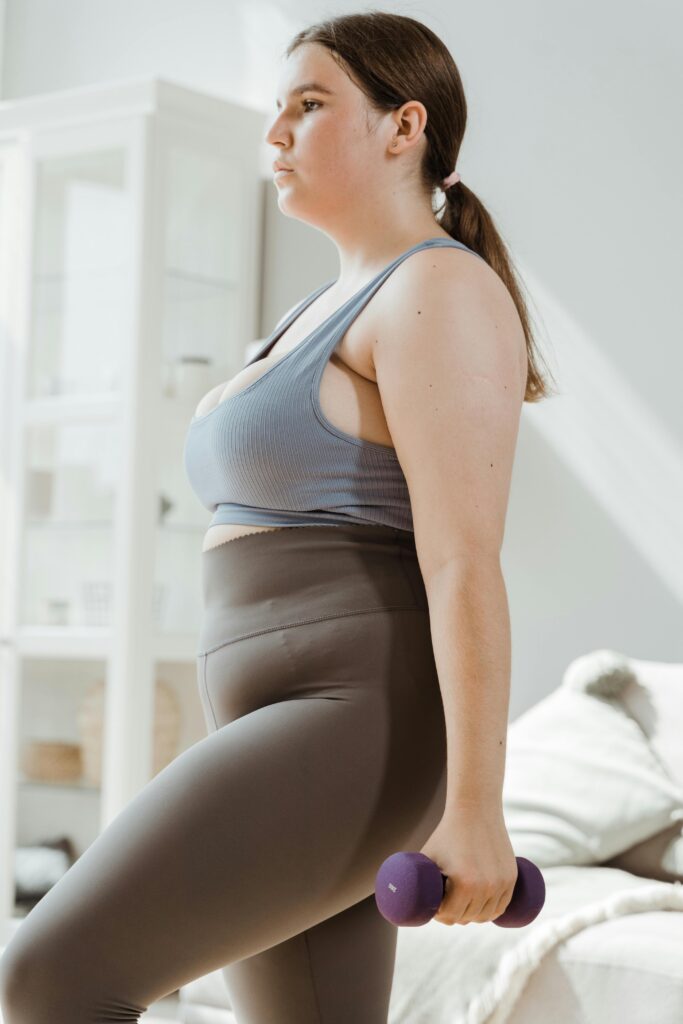A Beginner’s Guide to Lifting Weights: A Complete Workout Plan
Introduction
Embarking on an adventure into the world of weightlifting is akin to unlocking a treasure trove of fitness, strength, and empowerment. Yet, for many beginners, this journey can seem daunting, shrouded in mystery and uncertainty. Fear not, for within these pages lies the roadmap to your transformation. In collaboration with fitness luminary Jennifer Jacobs, we present a comprehensive guide tailored to beginners, answering every question and quelling every doubt. From the fundamental benefits to a meticulously crafted workout plan, let’s embark together on this exhilarating odyssey of strength and self-discovery.
Benefits of Lifting Weights

Diving deep into the myriad benefits of weightlifting reveals its profound impact on both the body and soul. Beyond sculpting muscles, weightlifting offers a wealth of advantages that enhance overall health and well-being.
1. Muscle Sculpting
Weightlifting helps in building and toning muscles, giving your body a leaner, more defined appearance.
2. Bone Density
Resistance training increases bone density, reducing the risk of osteoporosis and fractures as you age.
3. Joint Health
Strengthening the muscles around your joints provides better support and stability, helping to prevent injuries and reduce pain.
4. Flexibility
Regular weightlifting improves your range of motion and flexibility, making daily activities easier and more comfortable.
5. Sleep Quality
Regular exercise, including weightlifting, can enhance sleep quality and duration, promoting better overall health.
6. Posture
Strong muscles contribute to better posture, reducing the likelihood of back pain and other posture-related issues.
7. Blood Sugar Regulation
Weightlifting helps improve insulin sensitivity and regulate blood sugar levels, which is particularly beneficial for individuals with diabetes or at risk of developing it.
8. Cancer Prevention
Research suggests that regular physical activity, including weightlifting, can reduce the risk of certain types of cancer.
9. Body Image
Regular exercise boosts self-esteem and body image, helping you feel more confident and satisfied with your appearance.
10. Cardiovascular Health
Weightlifting improves heart health by lowering blood pressure, improving circulation, and reducing cholesterol levels.
11. Mental Well-being
Exercise releases endorphins, which can reduce stress, anxiety, and depression, promoting overall mental health.
12. Weight Management
Building muscle increases your resting metabolic rate, helping you burn more calories throughout the day and manage your weight more effectively.
The fountain of youth flows not with water but with iron.

Equipment Essentials
Building your arsenal of weightlifting equipment is essential for your transformation journey. Jennifer’s sage advice directs us to the cornerstone of every home gym: the humble dumbbell.
Dumbbells
Dumbbells are versatile and come in various weights, making them suitable for different strength levels and exercises.
Resistance Bands
These portable powerhouses offer low-impact, joint-friendly workouts that can be done anywhere, making them perfect for beginners and seasoned lifters alike.
Kettlebells
Kettlebells bring a unique element to your workouts with their dynamic, full-body movements and primal appeal.
Weightlifting Machines
As your journey unfolds, the mechanical precision of weightlifting machines can help you target specific muscle groups and enhance your training.

Frequency of Training
Charting your path requires understanding the optimal training frequency. Jennifer’s recommendation points to the golden ratio: two to three strength training sessions per week. Yet she encourages us to aim higher, to push beyond the ordinary, and to embrace the extraordinary. With dedication and discipline, you can witness the fruits of your labor blossom in as little as four weeks.
Starting Slow
For absolute beginners, starting with two sessions per week is ideal to allow your body to adapt to the new stress.
Increasing Frequency
As you build strength and endurance, gradually increase to three or four sessions per week for more significant gains.
Rest Days
Incorporate rest days to allow your muscles to recover and grow, which is just as important as the workout itself.
Dispelling Myths
Cast aside the shackles of misunderstanding as we debunk common myths surrounding weightlifting.
Myth 1: Lifting Weights Makes You Bulky
Contrary to popular belief, strength training does not necessarily lead to excessive bulk. Instead, it helps you build lean muscle, burn fat, and achieve a toned physique.
Myth 2: Cardio is Better for Weight Loss
While cardio is effective for burning calories, weightlifting builds muscle, which increases your resting metabolic rate and promotes long-term weight loss.
Myth 3: Women Should Avoid Heavy Weights
Women often fear that lifting heavy weights will make them bulky. However, women typically do not produce enough testosterone to bulk up like men. Lifting heavier weights can help women achieve a leaner, more defined appearance.
Beginner Tips
Glean wisdom from the master as Jennifer imparts her pearls of expertise.
Establish Your Goals
Determine your fitness goals and establish clear, achievable objectives. Whether it’s building strength, losing weight, or improving overall fitness, having a clear goal will keep you motivated.
Warm-Up and cool-down
Never skip your warm-up and cool-down routines. A proper warm-up prepares your muscles and reduces the risk of injury, while a cool-down helps your body recover.
Start Slow
Begin with lighter weights and focus on mastering your form. As you become more comfortable and confident, gradually increase the weight and intensity of your workouts.
Seek Guidance
Consider hiring a personal trainer or using online resources to learn proper techniques and get personalized advice. Having expert guidance can make a significant difference in your progress and prevent injuries.
Stay Consistent
Consistency is key. Stick to your workout schedule, and don’t let setbacks discourage you. Regular exercise will help you build momentum and see continuous improvements.
Track Your Progress
Keep a workout journal to track your progress, noting the weights you lift, the exercises you perform, and any changes in your body measurements. Seeing your progress on paper can be incredibly motivating.
Listen to Your Body
Pay attention to your body’s signals and avoid overtraining. If you feel pain or discomfort, take a break and consult a professional if necessary.
Beginner Strength Training Workout Plan
Step into the crucible of transformation with an exercise routine meticulously crafted for beginners. Each exercise is a brushstroke upon the canvas of your potential, sculpting muscles, honing strength, and fortifying resolve.
Warm-Up (10 minutes)
- Jumping Jacks, 2 minutes
- Arm Circles: 1 minute (30 seconds each direction)
- Leg Swings: 1 minute (30 seconds each leg)
- Bodyweight Squats: 2 minutes
- Lunges: 2 minutes
- Hip Circles: 1 minute (30 seconds each direction)
- Dynamic Stretching: 1 minute
Workout Routine
Day 1: Upper Body
- Dumbbell Press-Out: 3 sets of 12 reps
- Bent Over Rows: 3 sets of 12 reps
- Dumbbell Flyes: 3 sets of 12 reps
- Overhead Press: 3 sets of 12 reps
- Bicep Curls: 3 sets of 15 reps
- Tricep Extensions: 3 sets of 15 reps
Day 2: Lower Body
- Squats: 3 sets of 15 reps
- Lunges: 3 sets of 12 reps (each leg)
- Deadlifts: 3 sets of 12 reps
- Leg Press: 3 sets of 12 reps
- Calf Raises: 3 sets of 20 reps
- Glute Bridges: 3 sets of 15 reps
Day 3: Full Body
- Kettlebell Swings: 3 sets of 15 reps
- Push-Ups: 3 sets of 12 reps
- Plank Rows: 3 sets of 12 reps (each side)
- Goblet Squats: 3 sets of 15 reps
- Russian Twists: 3 sets of 20 reps (10 each side)
- Burpees: 3 sets of 10 reps
Cool Down (10 minutes)
- Walking or Slow Jogging: 2 minutes
- Hamstring Stretch: 2 minutes (1 minute each leg)
- Quad Stretch: 2 minutes (1 minute each leg)
- Chest Stretch: 2 minutes
- Shoulder Stretch: 2 minutes (1 minute each arm)

Conclusion
With knowledge as your compass and determination as your guide, you stand poised at the brink of greatness. Let this guide be your beacon, illuminating the path to strength, vitality, and self-discovery. Through sweat and perseverance, witness the metamorphosis unfold as you sculpt not just your body but also your destiny. Let the iron forge not just muscles but character. Welcome to the journey of a lifetime. Welcome to weightlifting.
Q&A
Q: What are some of the benefits of lifting weights mentioned in the article?
The article highlights numerous benefits, including improvements in muscle-sculpting, bone density, joint health, flexibility, sleep quality, posture, blood sugar regulation, cancer prevention, body image, cardiovascular health, mental well-being, and weight management.
Q: What basic equipment is advised for beginners?
A: According to the article, regular dumbbells are a good place to start because they are versatile for different strength levels and exercises. Furthermore, it discusses the benefits of resistance bands for joint-friendly workouts, as well as kettlebells and weightlifting machines as one improves.
Q: How frequently should beginners lift weights?
A: Beginners should aim for two to three weightlifting sessions per week to make consistent progress. However, pushing for additional sessions with determination can accelerate progress and increase confidence.
Q: What are some weightlifting fallacies that beginners should know about?
A: A widespread misconception is that weightlifting causes excessive bulk, which is not true for most novices. Weightlifting sculpts the body without adding unnecessary heft when done correctly and with care.
Q: What advice can novices utilize to improve their weightlifting experience?
A: Establish defined goals and maintain a consistent training regimen. Prioritize warm-up and cool-down routines, begin with reasonable weights, and concentrate on form. Seeking direction and allowing for rest is critical for long-term growth.
Q: What if I don’t have anyone to keep me accountable?
A: While having an accountability partner can be helpful, there are other ways to stay accountable. Consider joining online fitness communities or social media groups where you can connect with like-minded individuals and share your progress. Additionally, setting public goals or using a fitness tracking app can help keep you accountable.
Q: How do I overcome setbacks and stay motivated?
A: Setbacks are a natural part of any journey, including your fitness journey. Instead of dwelling on setbacks, focus on what you can control and take steps to overcome obstacles. Reflect on what you’ve learned from the setback and use it as an opportunity to adjust your approach and keep moving forward. Stay positive and remind yourself of your long-term goals.
Q: What role does mindset play in staying motivated?
A: Mindset plays a significant role in staying motivated on your fitness journey. Cultivating a positive and resilient mindset can help you overcome challenges, stay focused on your goals, and remain motivated even when faced with setbacks. Practice self-compassion, gratitude, and visualization techniques to help keep your mindset positive and focused on success.
Q: How can I make exercise more enjoyable?
A: Making exercise enjoyable is key to staying motivated. Find activities that you love and that keep you engaged. Try different types of workouts to see what you enjoy most. Incorporate fun elements, such as music, workout buddies, or outdoor activities, to make exercise more enjoyable. The more you enjoy your workouts, the more likely you are to stick with them.
Q: How do I stay motivated when I have a busy schedule?
A: Staying motivated with a busy schedule requires planning and prioritization. Schedule your workouts like any other important appointment and stick to them. Find ways to incorporate physical activity into your daily routine, such as taking the stairs instead of the elevator or going for a walk during lunch breaks. Make use of short, effective workouts that can be done in a limited amount of time.
Q: What should I do if I hit a fitness plateau?
A: Hitting a fitness plateau is common, but there are ways to overcome it. Change up your workout routine to challenge your body in new ways. Increase the intensity, try new exercises, or adjust your workout schedule. Additionally, review your diet and make sure you’re fueling your body properly. Sometimes small adjustments can help you break through a plateau and continue making progress.
Q: How can I stay motivated to eat healthily?
A: Staying motivated to eat healthily involves planning and preparation. Plan your meals in advance and have healthy options readily available. Focus on the positive benefits of healthy eating, such as increased energy and improved well-being. Allow yourself occasional treats to avoid feeling deprived, and remind yourself of your long-term health goals.
Q: How do I stay motivated during challenging times?
A: During challenging times, focus on what you can control and take things one step at a time. Practice self-compassion and avoid being too hard on yourself. Seek support from friends, family, or a fitness community. Keep your long-term goals in mind and remind yourself of the reasons why you started your fitness journey. Stay positive and resilient, and remember that setbacks are temporary.
Q: What are some effective ways to reward myself?
A: Rewarding yourself can help keep you motivated. Choose rewards that are meaningful and enjoyable for you. Some effective ways to reward yourself include buying new workout gear, treating yourself to a spa day, enjoying a healthy meal at your favorite restaurant, or taking a day off to relax and recharge. Rewards can be small or large, but the key is to choose something that you genuinely enjoy and that reinforces your progress.
Q: How can I stay motivated when exercising alone?
Exercise alone can be challenging, but there are ways to stay motivated. Create a motivating playlist to keep you energized during your workouts. Set personal challenges and goals to keep yourself engaged. Track your progress and celebrate your achievements. Consider joining virtual fitness classes or online communities where you can connect with others and share your journey.
Q: How do I stay consistent with my workouts?
A: Consistency is key to achieving long-term fitness goals. Schedule your workouts at a time that works best for you, stick to your routine, and make exercise a non-negotiable part of your daily life. Regularly review and adjust your workout plan to keep things interesting and challenging.
Embark on this journey with confidence and determination. Your transformation awaits, and with each lift, you are one step closer to becoming the strongest version of yourself.








